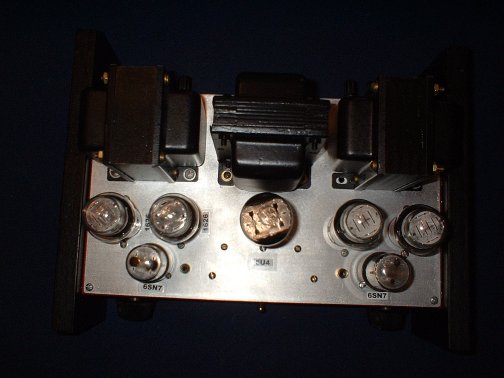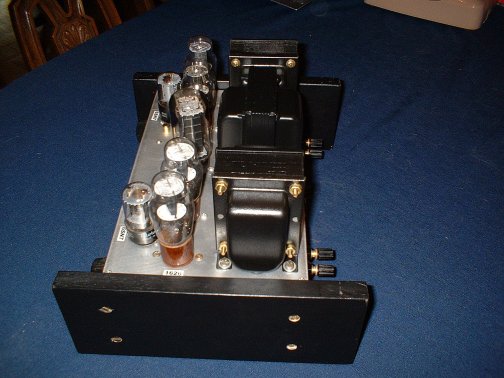




This project began with my desire to improve the tinny audio I was getting from my 'economy' 20 inch color TV. Describing its stock audio as tinny is being kind. With its tiny 3 inch speakers located about 10 inches appart you would never guess that it was a stereo TV.
My budget and space requirements restricted me to a 20 inch screen. I decided to compensate for that with a decent audio system.
In my first attempt I used a surplus dual channel solid state amp. That was better. I got more of a stereo effect and better audio from larger speakers but even the larger speakers delivered a flat, tinny sound.
My next attempt replaced the solid state amp with an Eico HF-81. I now had decent audio, but only after some serious work on the HF-81. Garage sale tube audio amps don't make it to the liqudation table because they work well.
I browsed the internet searching for tube audio designs which might be an improvement on even the good sounding HF-81. I found the Darling amp by Bob Darrielak. I also found several variations of his design.
I tried Bob's basic design first. I thought it sounded better than the HF-81, but that may have been because I wanted it to sound better. It certainly did not sound any worse. I liked the darling amp because it was much simpler than the HF-81 and it was something I had built myself.
My only problem with Bob's original design was microphonics coming from the 6J4s. That may have been because the two 6J4s I had were microphonic, but something told me that I was not lucky enough to have the only two microphonic 6J4s in existance. Besides, I was not getting the gain I really needed.
Before making any real changes I decided to try a DC coupled darling using two 1626s per channel. That did not work for me because I could not get the 400 vdc B+ from my power supply. I did not have a suitable power transformer to rebuild the supply. Possibly I could have replaced the 5U4 with solid state and picked up another 30 volts, but I feel that tube amps are not real tube amps unless they also have tube rectifiers.
I decided to keep the dual 1626s per channel thinking the small amount of extra power would be useful in driving my mediocre speakers. I changed the circuit back to normal RC coupling as in the original design, and I decided to use the two 6SN7s I had to drive each channel with two stages of amplification provided by each 6SN7.
That brought the gain up to the level I needed. It also got rid of the microphonics. There was no longer a 'ping' from the speakers when I turned the power toggle switch off. It also bought me an amp that a tendancy for 'motorboating' at full gain, and there was just a little more hum than with the original design.
The 'motorboating' was solved by providing more power supply decoupling between the two triode stages of the 6SN7s. The hum took a little more work.
The hum was being picked up in the 6SN7s. The main power transformer only had one 5 vac and one 6 vac filament winding. To get my 12 vac filament supply I had added another 6 vac 1.2amp transformer and connected it in series with the 6 vac winding of the main transformer. The four 1626s were connected in parallel across the 12vac winding. The two 6J4s filaments were connected in series and then across the 12 vac winding. The center tap formed by the series connection of the two 6 vac windings was connected to the cathodes of the 1626s. I was using one common cathode resistor for all four 1626s.
After replacing the 6J4s with the 6SN7s, the filament connections remained the same. I was shocked to find that the 6SN7 requires 0.6 amps filament current! This meant my filament supply needed to deliver 12 vac at 1.6 amps. The filament winding on the main power transformer had plenty of reserve current, but the little transformer I had used to get the 12 vac was only rated at 1.2 amps. I am not sure if this could have contributed to the increased hum. I did not attempt any measurements, but I knew this was not a good situation.
I ended up rewiring to run the 6SN7s in parallel across the 6 vac 1.2 amp transformer. Each leg of this supply has a 100 ohm 1 watt metal film resistor to ground.
The 12 volts for the 1625s was derived from the 6 vac winding of the main power transformer using a doubler circuit. While I was at it, I also added an second cathode bias network so that both channels of the amp were not connected to a common cathode connection.
Once these modifications were made the hum was reduced to a barely audible level. You have to turn the gain all the way up and place your ear right next to the speaker to hear any hum. I left it at that and called it good. Using DC on the 6SN7 filaments and adding some input shielding might have improved the hum situation some more, but I decided the additional effort was not needed.
The end result is what you see in the pictures. I was skeptical about the 2 watt audio power level being able to drive my mundane speakers, but I can drive them to ear-splitting volume with no signs of distortion. There is something very satisfying about watching movies using a good stereo system. It more than makes up for the smallish, 20 inch TV screen. Even at normal volume there is an audio presence that can be appreciated even in the room adjacent to the den. I have not done any testing of frequency response, but I know from listening that it must be good. The audio has a natural sound to it. I hear sounds the solid state amp would not reproduce well. The metalic click of a pistol being cocked in an action movie. Background noises in some movie scenes that used to sound muddy are now brilliant and natural.
Is the darling amp better than the HF-81? Perhaps. One thing for certain, it is not any worse and I can build another darling far easier than I can build another HF-81.
-
HOME
OFF TOPIC BLOG
Amplifiers, audio
Amplifiers, RF
Antennas
Boatanchors
CW Keys
DRAKE radios
Equipment for Sale
Ham Radio Misc
Parts for Sale